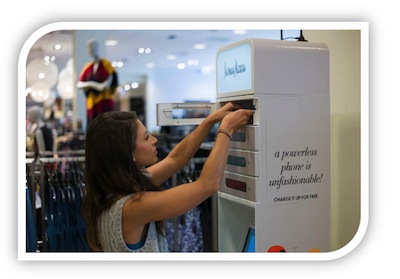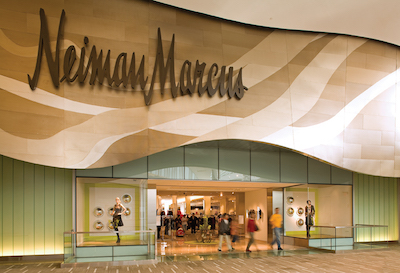While retailers recoil from falling stocks, Neiman Marcus is still awaiting its own IPO and transfer of ownership.
Neiman Marcus first filed for an initial public offering last August, with delays attributed by Bloomberg to a failure to secure and underwriting bank. Labor union Unite Here has unveiled a report, entitled “Sticker Shock: Can Ares Management Sell Neiman Marcus,” that examines recent obstacles the retailer has faced that have jeopardized its IPO and hindered the potential for acquisition.
"Neiman Marcus has struggled to respond effectively to external problems," said Elliott Mallen, research analyst at Unite Here. "Ongoing litigation following a data breach in 2013, overexposure to declining oil prices and unfortunately-timed website outages raise questions about the soundness of Ares’ investment in Neiman Marcus."
"Also, after an abandoned IPO, Neiman Marcus remains hobbled with debt as executive leadership heads for the exits," he said. "Given these challenges, will Ares Management’s Neiman Marcus experiment comes to a satisfactory conclusion?"
Road to recovery
Neiman Marcus is currently owned by Ares Management, which is seeking to sell the brand. However, Neiman Marcus’ long-term debt to EBITDA ratio is unfavorable compared to competing retailers such as Nordstrom, making it an unfavorable target.
Neiman Marcus’ debt to EBITDA ratio is four times as high as Nordstrom’s and its interest coverage ratio is one-sixth of Nordstrom’s. Such ratios are unfavorable to private-equity firm or retailers.

Neiman Marcus mobile shopper
While Ares looks for a buyer, it contests with a market that is waning off of material goods and particularly in-store purchases. Neiman Marcus has had two straight quarters of negative growth, with a 5.6 percent loss of revenue in Q1 2016, 2.4 percent loss in Q2 2016 and a 4.2 percent loss in Q3 (see story).
Additionally, six executives with a total of 87 years at the company have recently exited. Among them, Neiman Marcus Group CMO Wanda Gierhart stepped down from her position this part March (see story).
While Neiman Marcus is not unique among retailers right now – almost all are posting declining revenues and watching stocks fall – the unfavorable share of earnings going toward debt relief gives it a more severe burden.
While the brand’s most recent announcement, from last October, projected an IPO offering in 2016, it has neither formally delayed the offering nor announced any progress.

Neiman Marcus
According to the report, Neiman Marcus has also failed to grow its customer base to include younger, less affluent shoppers, a goal stated in 2011.
Neiman Marcus has also been heavily dependent on U.S. markets despite the market’s relative retail saturation. The brand attempted an expansion into China in 2012 by purchasing a share of online retailer Glamour Sales Holding Ltd., but the venture flopped.
Despite shifting consumer attitudes and recent miscalculations, which also included a data breach and Web site outages during the holiday season, luxury retail is still on the growth track. As Unite Here notes, Euromonitor, Conlumino and CBRE all foresee growth in luxury retail through the end of the decade.

Neiman Marcus storefront
With growth potential ample and expansion outside the United States always a possibility, Neiman Marcus’ IPO delays and recent revenue shortcomings feel like the result of a recent unfortunate run rather than a gaping hole. A fine-tuned business strategy could put them on the road to recovery alongside the U.S.’ own economic recovery and overseas acceleration.
Retailer struggles
Most retailers currently are elbows-deep in something of a mixed bag.
Retailers’ stock values are plummeting, with stocks reaching historic lows as earnings falter.
Nordstrom stock stood at more than $82 a share on March 20, 2015, but on May 20, 2016, opened at $37.25, its lowest in almost six years, and its competitors have had even rougher fortunes. Retailers are trying a variety of strategies to get out of the rut, but broader economic turmoil has walloped the industry, and no clear solutions are visible (see story).
Other brands have also delayed IPO in response to external economic difficulties.
British apparel label Belstaff recently announced that it too will hold off on its initial public offering plans.
The brand has put its IPO plans on hold due to the Brexit vote on June 23 that decided whether or not the United Kingdom would remain in the European Union. The vote to leave the E.U. has caused uncertainty for the U.K.’s market and resulted in pound value fluctuations (see story).
{"ct":"knrkILyN5HZaLsIRqsOn2SMOJNpvtiPDI7aGZzAkNexvFVqvuEr3VBBfDVJVPEcuQfl4qE66L\/mmgqkGILXjgiDDmF8MZpkCQN3ioSAXBvAe1VM+I24N8muja8hPtSrLql6OmPjfeJjOpG5u9IrXONpXaLg5uUvogY3GD4DHGCkvMA6HCzlUrcPwJp0hIk1Usvb\/fmI9tulXvYTJQs\/ZrBdn3Nyg1LFYl5LcgzwE3I8o2JTNiwXMVMtUL0GMCZzlvYEb5F\/Lda7\/9WCXZuohMtE2OO9b5emSMknpwafJRJlMWFKPP6hHdZ7kSkpuEx+dJ5UnYBTum43D0bV+TTlA4TcXaHQ8v94B3XEyhS+m+8sgyByb5NypX1x6alHUAuvwnXT7Gh85FOt0WIQnqVV3WDAjwVonJM6i1tE6bqTmI0BBS0WyjnpMYu5xX0Q0onqBtU6nKFZT+beLW8Oy768dGepEbquLroTmxgU\/JK6QUIV9fRWOxn8jTXJ+T8jblkmpSE2VywkemqlZYOmua1vcqIbCPbUu26ugSRGZJVBtIvh5Q84boAZJLRniNkEO70TTV\/7gryPz+uurAOsOpgZVzkx0m+VIzpSZm5ZQTZ3tF84bdJ+EHFlqrbzByC6OClj4tYj\/3deddepoOR\/QDBDi+N7jtiDhQ0kyRMpVgyaQomyqgzFpzxNX0A9MeiieMbkdbhUPtZzJKq64AZtB6rlqlbVGKBF0\/cpu1pPU+SH2b6Oz5CUZG7\/D4QcYR\/WET4VojdYjgBnLVEJt5pqp60gcW+2Y89I37TA0EtdqpDpe38JGnn+dLmvLnt80RXirnMQwGgpzoMYOvclKWjBnrPVVhBgukU5cPghLaoe+LenyWY7fnIuV5Klri05DBNFkpnPleRuN\/xPA8U7ze1Hwjr7s9EyKPjrLvhvldphQjgP6pODQLBEaNGpbcVo8a7j7RGcFUJGQ5i89fRSGns09tlwoRcEHNxZeURaONVEMhLxyPb9eiZ6hYqmNua7pNarNgwHsBI83fu6AggEXRH5WHOyLr3zd2h4KHFYtGvPmJBzWIELWD+e5jeH1IoEaPn86JsoS+ha8u\/Z394o0c1WKOV+fdsO8IGn\/KR1Tef6vYG\/2tJIvHivpjEtk6iuGZsiu\/Nbbck8RILL2AvNb4HVYbIJMVhVVutcj9KfVenhV1A3C6oDMmUIrvtGcb+seGCc0tO7dTL66Y\/H2m\/f1Py8v5wrhuiOPmxqnnXWyVpLGDGFDL4hMmq6vpeGu7X2TL28t+XryGBdiO63252DsH8jmsZ+P011NgcdrjaB77r5v+ltjjq2R0P9E4qu4NPbMUtDkjc1mMvrswwWgjC3kXuEvtfgrYGfIEWR1mPaiWgAqDtb4xFZ8DV\/UjUmcLF1\/KAXzsxelILmbsk67WTZxFf16iugDqOG35vmOqyK6ldwm8dsw+stYEfdtK0HsdzjYH9Z4BOkJv6UfsTtEFCCNogDmuaREPC0uxuQ6jogMjeEprKFhji7s3CzOash75KVJA0cnvbRcomoMUEmla5cHo95gkn3cZJ4cvGKz6\/BLnnX3MG7oeHUWoYZLvc01vA8TfAfOpPqnPnvFKyPOMHjerIR9S2EHR2NeS9zEBlVhVDH+MsWkYw2MMZmslfxOTXZB9WLi8fS+G7yPU8HCPHc7zx2WZKSmZtVuLASEIBRHjsi5PtbyVnCQ9urSjMjlXnfnS\/I20BDOGCV90n5OB8sjzTUNTqLdThPWqmZS0Jux88zRhIBLYrgLN1SV2aA1M0fnavn190AuVkxRe3eNqlymMa7R1TnPPpAIP4gHOqgI\/unoGiGcoGOl9nxcPQEbBn5EeH7ffPEXw1b3ucUmYyJzb64pYEpFV4lgGTP7GVgUKFL\/cdg9S52Lk4dA1ROMPLdsFjrpxn8LHq0LMENZhyJx40IU9K9g157GCMwwwpjZ61yxEXGppFC6jngNrqcIlccXQvhl7Yjd0iONehSPkkeJhSdWlqyq2T3FOT3XOhW143uMzgfd3m1rL0q6DAu56dA3t4x\/7UoqcoeDQ9iXkQKH\/wNSMtIUDqGfGf1OyDGXD6eyRP5JOSjrKlgIZHueBaPqdQww427er8\/LzlOpsnrxK48ns3uHejHD23eA9uqB46Vj3fZdFPqMYICWWOm+kkjtjPNd2\/YFgJdwT0hlLgsrv\/jNEzD+GGZ\/qiIpPoKIQy5evquaJRnwxYVzu\/5xfc+SYtPqwEqsDiYhpeoLlbglQV9QE9+eQWDJRwR0gUiX8h7jmw+tuCUmuS8nG6\/UEDEyLburV1CmfiVnx4bjv\/SHoT4TY0cvoT9beyriAIO\/7eZxcyjpIH3PrMlyIE5Jq+d1RT\/QikuJqM4GBk5VLNzMt7H7LCIdoAte+Spm2ejY+aFIclxSWnYz1MxLsQJq5ukSiuWpywqhZDXv\/YAD0KxzPb0VjRo9tYJQmRm0V7mY7FO9dU1ywQ6Tj2AZFlB23IFa\/yUkoQ1wYY6tkbnyT8oA97MqjKabm16nMohfdRg\/gsuosuieLmgq\/wC6XlVwopfFuESwuQfEeKbQ3NSDvU1dOy5JLkB0q41wwsZHVYK98oR7bDhDfJ85Ys5pivn3a03p8nkraGBkg9oTAehC6BE70Ev2puKZd\/epciPO7fEx7W95BflPNcojrmwqSYC9fqrR+yQTcYOf6epnZAE9VwPV2HuRI05uLNyIQdv\/Ng1\/+UCP36guAYtLtOHhUoDWbh\/itXyhFJsGiWROm\/v2T03IH6YQIYs8\/XT1CyRVKUPYCv6LJxkFJRg3oKnn\/KyhEzvvqLybJDB9ri5UVKmIqmCTrPKm5UK368irV8WwygG2N+d6AijnhcxeJt79OCx3nN4vzbZGNAMHEWGvNPs+xEHl2NAhoNAX3j139yVj\/A5sGxffQxYGScE\/Mete6frEW\/yWgQg\/ugd1T9ILNN55xXnlsK4cAn+hs09PauHLCmnu9Fj01ttbFtu\/xw4qxe2JwprT5RLL9pJ\/FdYjlSmkvqnDulcXOvCqaHb25pXCM1E\/SxjR6gIflDFWWAla7+nu4j2pYTAyoFF++cYNJkRLirNvp0SBn7ZPdcS2eJ2W69Pq0N7UpbqNgDgsDlsU1FhBQauLIiAkvMFJJKDn69R1W\/O9edjtdegw4e6oyNAcM0rSkh7Fp20RAvJWxlsGnA16JtQ1OuzRErldtuif1p4z46hhdJf3PAFF\/vk9WmSZOmofjUGmJmty\/xjBD110SZtAFJ8TholqtuDS3dnantJK3U0Oul6B4UQiz4GTjV7gOeIyKO0hJZG27RnkPlqzydxD2pJgk7TIjUNC8TORWtLImraKtgCqKJ+W1wcKj+GCpOYUcNGM9ZoMq3DQSdmsGsWF3P6KYWavh5MnUDLIkkY9u3eyTqahYvP9\/9vMUdFPoRM7S+QIE01sHlCZlRrY6RY7YW3CNtnVKTt+1BXYzg5QIbMifZJ8ftH8ARmK5IUJZ0K1+fiG+fnGiFIZqY3uID3CMUvOch1G0nLj\/dgs9Y45Ncs4\/oVMZQ70NDzR9uoIcEctS9c30XIiok0frukF1x8ML+7jLVdM2\/5oV2AKVsm6yJ5jIky4+umTOEHABkP7wTl\/UuGfAyyCAs9SsuLBDCB84\/ExV6tb15\/NhDXrnbkXbcH3jYq6q9nL3ZWn2DiNOy6csv93b3wfthpBymQwezhfwZbbWU+xKemkMgST3P\/t+jSIULETXIu6n6BHA++34eXWfB+qBqduCx8\/Z6B1mpdP6cQXE3Pz2aiQZZdX8inUhDanhfVpG17e9TBoI3x2wxsNCSGSauXMoLQXXCIuI8iPYw5ypjUinw14NDnL04RxDiK99SygnYZiTNpId0nyt4GWjB5QL8JKsMkWCOTH6FARpFay0Mdu2K+RCJ3O77TXjYvmztVq6xIJ7Y9pXPEw2N\/xfBzWwaud0TJuEOhXJKPSXbrtF0YkrtHGN0OzNdJQRqCAFhokx88k1Ko65do9\/rM0kekHrLFZnZn1l5B9SiiKImpkIRml5Zq7VXLw1B4V15ZkoYn9ibDGWU6qmnc6tyE75Dr1CP8g4UDjJ1aDjaCx7kE3V5ujKprhtdp+oaAVJI4yrCmWgiW4FYfXRL7VCiRS63G+2cRDKjSqv\/A27GmCixIV8uhP5LWa0P6hIHjPM8Xklv9DGaqoZ2YCc42343Uaf8cDZaVXRv4u7kEe5YaLg7B+V3Hwrp1FMee5VPoAHVjTGB9On\/1ViwqsI+Btfhm1CB9+pFZtm7XCdyYgvXq9mlVA6RkY5H0wYYsE5kymHKQtFday2u4dMcFxJGUL25UVZhjS853Np8mn6SU+1UedKkoDy\/pDRJ9ORaPbLeGqyOJEYqwB9OJp6A4BjmNNmfQgYlD07WiKQKT0jPbQWtk308ZcSJb4x5NmBVPP\/3oSDGAAdObdxsY0DIKILhJb2eC7B8W3pziu2RWHfyU+JcjwMM7IFIuVSHBJ3NmWCAJPBrfFHi9jxijuaHC+yZAGlgNhKmKeipV98qC9ukD9+Ac0JL96lDI6xzL+2ygcUi4lRQJOTDcS23PeFpqxSldP\/Fkp8WbYD8HR3h4hkWbx8eM1caklv6CcX6RcvDvYXTIvJhsm4VoYGjoZDnC2Bm3VNafoK0u7l4OZB1\/Ih8w8\/8ARFAlpVvcV\/TTEhvPg79txbtgKQD3ZQY1rszmtzsyx4BT9b0+J15DwazYrVndw2Mr1zS\/IozZoCtHp+tUgJiy3mAcGSjppNYebNtLrZwHPJpLYdltOTpOhlLGhblZddDD9+osEuc2PR4aHOInHnHGzQfylnGMBspZ0a0MOLeek8062GBoAd3uJ+LwUDtx5TWUhBI5pitEm1KqhGe+\/wDJpgj9lTiS6V13\/ZWjL8ke+YT455N1qZxdrjTKrUJyleEfxjOK7s+jUjVHnS\/T\/w4UXmJlBcBp5FZJcO+9CgSZC3FwR7Zsa++xwz9kUrSJlSBZZsVRV\/neOwT+lH4yvoUx7vVo5maBc6oDNyP7YXq5yEQQcACTwciv1tky\/mlhtzQxgcgWUnGFqcLIYwYgdzLtJdKcagwZ\/xN2ortH\/GEU5jRN0vVua6ZYjmZ4ECTrfayz8IOaAR2s8MR4J+0r0djKl\/+0wp+iYsIq5yksHwe7otlV9VioRtAs9DqfF9KnKCMHogVhwUbs3bXDmtMRJDsFvusrFzj+xHl7ykLJBVLpsSBc++MMKB6XfWxxZ7gAPKNnF5bP6Lnb9vVpIHBcQTHxIrfUneF9gPMr+cOck7aZltqqhlkWwUVI33kCUetSnyF+fjzXGg0AnEL57KMOpZc+3\/jaS3IVUYKHeqdXGoRDJWU5Zg\/jQPNNSQ+LTGy\/xhyxXws7UR6bbg\/6R83VrxexzQviarHRceyc3UkiycDYQEYe\/nyfYFVoJnSn\/H3KS9cDSYRUjenDgNJAkvrq5PV+CEC6+3S3p7JXq5UjwKpMODjrDNWPPWEhsw50DsVi4qw674H2HR0uvHSQh14AtHDiu+6jnNP2\/WKttx\/d\/3PRL0jp3UoB5U\/Ikxl3v02OhoI6s0w9v5Pz5XvCCjdgD1yGf7lwjtOo4Bh\/QCCgjSyu0wswPjbHMTjYkMlwZwfkjW3ey7qoqUnS4gRsAozw8yDVbpa\/ydBYvNk5dkCYxoW+xDqMbexRWieTKkfHF8ci\/6NHRJZZa1ys6TrUg7TSZ1vdjVkwBbMyDPEfS12qS8YRShYcBHByWbjg29lHPrk27WJOpt3blSLX2ZxnUw0R5UycWf0KwSmq2FlL7KadiCQyzBZ061q5DJjn\/8bCVMMxOEEuPsE1OGkS99mysuvglZU\/zvfEq0AiLsiPqMNlNTaje5cq7iP3enP5f2+p7fsmh9EKuTQc6nyRM8B8X+YOlkd6dIZOhKKsHvZs1fK\/gjOh0RWVU9mw4hxpMGqAlkZfWUDU2vL2ZzlhKOT6ufV0gh50ubgM9gHMS9PZw2G7O0tqdlesv9Xw0Kp9QCBZopwytso6b\/egsz\/ND1tNiN5QDL1xtfBHv7YACNSA3t5fRR9mPXjDyX+MpuMgXaS4s4qm+zFgRycObkbIanlKNpqmU8a+tsvmW\/psAdt3mPdehgtjhfF+CO14DRfQFJc8YtMWYjA5oB1mGqZIdsQsNyX74K\/cOenv4ZQ8LB103BEHlF96hSXo0YWfVzh2IeqeRCbatyU0IK+423xG8pwUOROqxSPwkRVYi1KYI+\/Ztzjkym\/ml0VjX0GaQkLU14ANG6Br+WfhoagSXTPFOPpzBJaYI+hcoAe5SgRyKU9r5c2pCnmARD29p\/fsbUDDwfrLdhHpX9+cnyU5Uwvgg+23vgslmbfu\/5+oLiPAS89SCM4\/rmg3aTac53mOKRtN92sAsYmbGzEZM5WLwmb8y9x54dHg46Pi8mhFGDUn8nb6CmcgWxJFmjnYjzZ\/hmUEt\/A2O3EOHKA6o\/8oNlodXp1Aw0MbUg5ep9yv++pL9sJxTkbdIkMPLGcECWrhAKFhAtKo2sMj9VuXm9iZ9C719cfq3gBycMrrV56TipUPuXJAwr1mwARJM1A3H+BMOPzcEtZpjyCX6kpUFArdsEKdSUcIC3pZOumj81Vi+p4ROzwqSnNcqPZTm0e682Ta4Sg4s3aOnhu3yHc\/iC8OGFmlwlqtWNIOHZbNd4xBD6PekOozJ56IMR2pm8zG1R0HabTGPl\/58SCcEp9ophnzqS42lvCBlNBWFVd8c\/DrBV8elBnWg3X8IrGKXCBGcXNR9pK2RvVDBLi8mDtack\/0kqpSMfW643zCXwv03b9S82zDLu+H+dSLZwE+XYNwMNUd+XFIyvWht893NjqITyPlEO40hqpB+RK7Z+xwbFE9uANbjWrYg2pCHO0AePYYmxiuv03oR+JBOphwTLJAAL8pLFFAnyXd\/\/DbdE8U1ZyCDYIg8IyG7IR5tzBabRZ1\/3SIBJLUtJNKTObCBsIKS36\/nWo\/jc\/xTzLLu+jhbMxQV4nlC1n8xOP6Ex4WOME1NK3TIDfByGtkVoYABazPHq2WFxI3gj8\/8a\/JnhbPy491JWvC8qTnzamGtCJmSHARyPbIcxo1es73i8CK8ZLKk5XGiTvHbvu7eh1f9vv4jqDwp5iLFUNFKBwzfkK8PyAV1b59irxm2hcJ2GdgQLnrjntJQ7xBXhMkDW6ZwOfRI67f\/Z2lS+f1dFMOgmJ6DxOohGZBrmsX7FnPuTOy+4m\/Wz92PlPyZ2rmnDGDeU8sm3Pl89\/oURwudBw7VFBCwAZDlLEb6UPbp\/qqDl5BnE+7KDeH779svgxWkJMZzhzs23hkhH10iB29yz1wqcZKu4jzDKzAfj7N+UAJB\/ZIsl+qSoVrjbqCpc\/LlEPz7TGbGB8HEsz5rVIFbRmvhi+o8FT6oZXfOwJiJQPsuv7JSAqCSOzEV1rlHVMo1irHGAnPymb\/\/AAJfGYoXNrNNB6r+FybNe+K1Ssp6y1tkY5bNsGaZQ5ljVm5JVhU4g8zJEagEcMecDIOenbTcKwvm9a6UCaXncaahg2snHQERzUO+bxhg1FIob9GrzJ6VMHUoej4vcJarGOMk6XBeULdudJ3pTYZqpGqHmLSwsmejmnTQq45rDpbqSQ0PLRkfQ\/vcuIFLikSwUbwtKQ2BpFr43T586tDrN4Ll01\/X6sDGs6oB6ojippAohnRGdPNCIjmlQb\/WBqVRiR1LIpz+XkyYL7iDWyAoxr9\/VggrLKRaKGPk9nXWVdLIlYtpKk0ZNtYs8RlAtJDdjUcc7Ga\/4u265i0WYTf11OzEwVnP\/NGU15H12oIRKSJCm6SFdpZrQdblSr749442C\/HGCSwiaj+Gm37dw++4mch4hzAwOddPN+piSyOtjMC0TSsufLsB+JdC11F1hBeT9Je48gcRE6AsrNfMQUQTK6\/ZAFW21p8VzGbEN1uob\/3qbuNjptbS8DzALq5OJMymLUQIaBUN890jUeMkkSOXHVmXsntc9ibfSIaMeeFhLHiqZ8fssFofmC+7Fu7QUBaK0q\/3WysrhvqB2e+Bv\/JpRtcxSFG4I4NWv5ZAcNc47TTiBW3AbyODfVAHLCJqj5mPtnBY8HLvfqyAwOkIsVPQurFa09Irzn3mSXB0fqlaHjmAOojlnzDighh29gtn\/R3ay0egS7PwZ\/6vR5JA3mazctw4Bhc80WY0aXdExqOqNJXz3H99BXSvc9ADc3HDQTIODVvVPpRyXhdhIO4PmIgX3CfWBFvoH+jrMXhNrD0N5POV97tVU9mCZDGWX7cd1WuZRNo0EYOQBcXhdIBDgrafULkunxEn61oJbI3MlxPRBp5u14mZT2kPAdq6ekU94lk+\/GvIIQitb4iu\/QKXNLFpJOXEp+Ds+FGkLN8ea+yns6QYw52dlXNqQ7ZoNRrP8GBGGB2J4jcNHM6fp+sRh+0DG\/24JLDNd4SeQOD03zdKLMHIneB9w2VwNggqPchG\/iojNRXUWD9W6yd3IT\/6FCz65XHqfJMurqqmHm+1qHeO5uW\/37e4Kh78EIFiWcko+Xq84dtxrLDU6VrJA6q29UR++K0rMV\/iXELFK+mg08tAa98yxoKuruYPLYQBDcqM4ytaFJH0hQxZwnDmbJ7vWD0tDwnAVFLHaPR4ogMucV\/u9O92XKKUQUJAPPJL\/ydzP7i4iYxigZW+DaJxld8+ihBRsqX8Ii+vp0WJd1zGqY34lv0pvkwBrtfZnlbr3n7GVy9KebQTq4D4DEkJbCitd7D797qn7LbJ8jmFoDomdtLcTrhlfCxl\/OX0EP4uidAzYCqd7BVQLfYBizODL0m5Pvr8RFxz1F36GvdANLXkLwmIeIcLGC57xId5F1f3nwAt6yXA2XZHaX0Q0FXVPutAAcrz7xfLbYjIvD9R8UzDUWcyzOiBm6xSV6xV","iv":"0569439f550eae183176e6d9ca1ec81b","s":"ce3cc1528ff1eb3a"}

 Dallas, TX; Photo courtesy of Neiman Marcus
Dallas, TX; Photo courtesy of Neiman Marcus